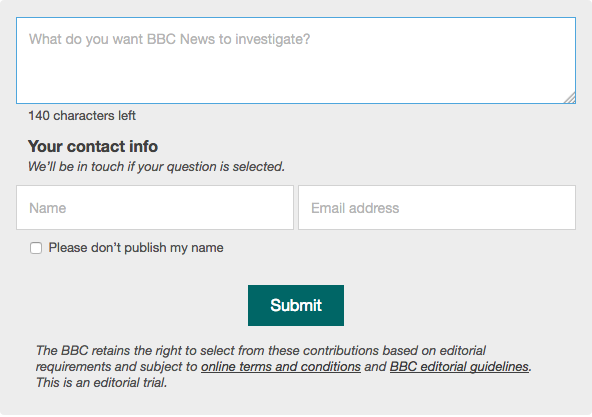The BBC has been using a tool called Hearken to better involve audiences in how the news gets made, and in which topics are being covered outside or as part of the news agenda.
The broadcaster's user-generated content (UGC) hub team began using Hearken, a platform and workflow focused on public-powered journalism, in September 2016, to get an insight into the type of stories people were interested in that the BBC could be doing more of.
The Hearken model is based on encouraging readers to shape stories by asking questions at the pitching stage, and on incorporating their feedback throughout the reporting process, as opposed to just asking for it after the article has already been published.
Some 20 members on the team have been trained in using the tool in the last year, and the way in which they approach it in their reporting has also evolved, Andrée Massiah, senior broadcast journalist at BBC News and Hearken lead on the UGC Hub team, told Journalism.co.uk in a recent podcast.
"When we first started, we thought it would be a good idea to add the Hearken tool at the bottom of web stories that we were focusing on at the time.
"So for instance, we would add it to a story about health and the NHS, or to an education story about the university system, and ask people for their questions about that specific topic."
To give readers more freedom on the type of questions they can ask, the team has created a page on the BBC News website where people can submit questions about any topic that they want to know more about, or that the broadcaster hasn't necessarily covered before. For example, the UGC hub is currently working on a story about train delays and looking into what signal failure is, after a reader enquired about it.

"It's topics where you might not think something is particularly newsworthy, but it's of particular relevance to the audience."
The hub gets "hundreds of questions" from readers when the tool is used, Massiah said, and the ones that get answered are sometimes chosen by journalists on the team, if the topic in question has come up frequently. Other times, the audience makes the choice by using the voting function in Hearken to express their interest.
Once a question has been selected, the journalist working on the story will include the name of the person who asked it in the article, as well as follow up with them to find out more about their interest in that particular topic.
The team also wants to focus more on investigating people's questions in video format, enabling readers to accompany the producers out in the field and actively participate in the reporting process.
"It's definitely been a very useful tool for us in terms of engaging with readers and to see what other ideas people have that we may not have thought of.
"Story ideas may not necessarily be 'newsy' but they could provide us with original content that we know would be of interest to audiences. This would in turn build trust as people have the opportunity to ask questions that we can follow up and investigate, thus engendering a feeling of inclusivity in the news process."
Free daily newsletter
If you like our news and feature articles, you can sign up to receive our free daily (Mon-Fri) email newsletter (mobile friendly).










